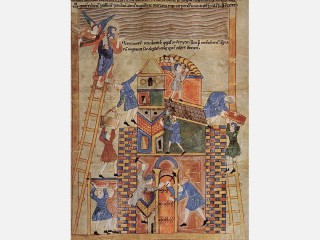
Aelfric biography
Date of birth : -
Date of death : -
Birthplace : Winchester, England
Nationality : British
Category : Famous Figures
Last modified : 2010-11-09
Credited as : Monk and scholar, writer, collector of sermons
The Anglo-Saxon monk Aelfric of Eynsham (955-ca. 1012) was a scholar and writer. His works, especially his collections of sermons, are stylistically the most accomplished in Old English. They were designed to explain Christianity to his fellow citizens in an organized fashion.
Aelfric was born near Winchester, England. His youthful studies at Winchester coincided with the revival of Benedictine monasticism in England. To this movement he contributed varied writings which preserved, translated, and disseminated the Christian tradition. Aelfric was undoubtedly influenced in his task by the recent example of King Alfred, who wished to make the learning of the past available to his subjects in the vernacular instead of Latin.
The chronology of Aelfric's works is not absolutely certain, but soon after he became a monk at Cerne Abbas, Dorset, in 987, he began producing texts explaining Christianity's message and history. He wrote his first series of 40 Catholic homilies in 989 and his second series in 992. These two collections explained the Gospel as it was read to the faithful every Sunday and on feast days; they utilized the critical interpretations of Saints Augustine, Ambrose, Jerome, and Bede and were theologically conservative in aim and outlook. Their prose is rhetorically brilliant yet always clear. In the second series Aelfric introduced such refinements as heavy alliteration, balanced clauses, and a rhythmic sentence ending, or cursus. For these innovations he drew on both ornamented Latin prose and traditional Old English poetry.
Between 992 and 1002 Aelfric revised and expanded the Catholic Homilies, produced other didactic religious writings and translations, and wrote three Latin works intended to aid students of the language: a grammar, a glossary, and the Colloquy, a charming exercise text for use in vocabulary drills, which is full of information about Anglo-Saxon occupations and livelihoods. A series of Lives of the Saints and free translations, often including commentary, of the first seven Old Testament books (the Heptateuch) occupied much of his time between 1002 and 1005.
In 1005 Aelfric became abbot of a new monastery at Eynsham, where during his remaining years he continued to revise and expand his cycles of homilies and to write supplementary works of instruction and edification, including letters to Wulfstan, Archbishop of York, himself a noted vernacular homilist. Aelfric died between 1010 and 1012.
The most comprehensive accounts of Aelfric's life, writings, and chronology are the two chapters by Peter Clemoes in Peter Clemoes, ed., The Anglo-Saxons (1959), and in Eric G. Stanley, ed., Continuations and Beginnings: Studies in Old English Literature (1966). For background on the Anglo-Saxon Church see Margaret Deanesly, The Pre-Conquest Church in England (1961). Stanley B. Greenfield, A Critical History of Old English Literature (1965), surveys Aelfric's literary context. Peter Hunter Blair, An Introduction to Anglo-Saxon England (1956), provides an excellent guide to Anglo-Saxon history, institutions, and culture.
White, Caroline Louisa, Aelfric: a new study of his life and writing, Hamden, Conn.: Archon Books, 1974.
















